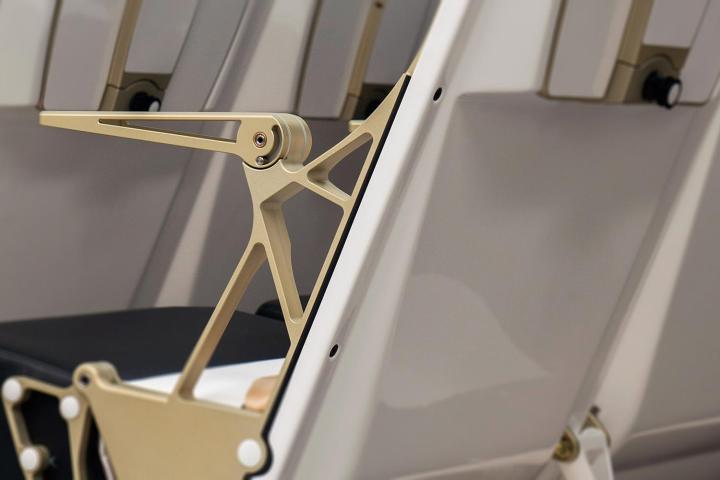
As we’ve discussed before, airlines and seat manufacturers are constantly looking for new ways to add seats (the newest are slimmer in design, with less padding). Some are ingenious, while others, like the backward seat, were born out of sadistic minds, intent on adding further punishment to a much-maligned experience called air travel. It makes the non-recline seats of Spirit and Allegiant look tame.
But, as with all tech, patents are simply ideas, and most will never make it off the drawing board. But as the industry continues to look for creative ways to generate more profit (pushed in part by Wall Street), let’s hope they never revisit these concepts.
Zodiac Aerospace HD31
It’s being called “atrocious,” “nightmarish,” and something that will “haunt you forever,” but Zodiac Aerospace says its HD31 actually creates more space for passengers while increasing the number of passengers (as many as 30), by turning the middle around, using a hexagonal pattern. Because you aren’t rubbing against your neighbors’ shoulders, the seats feel wider (up to 24 inches, which Zodiac describes as “high density in a business class width”) and you have more space to spread out. The seats also fold up to allow for easy access.
The images, however, aren’t as appealing as what’s described. The seats look like plastic shells with very little cushioning, and the fold-down concept reminds of us a public bus.
Much of the criticism from the press has to do with having to face your seatmates (heaven forbid we try to make friends on a flight), but Zodiac VP Pierre-Antony Vastra tells The Australian newspaper, “It’s a different way of travelling, with people facing each other. We can have nice conversations.”
If you think finding the best coach seat is hard enough, it could be worse. But Zodiac says the patent is just an “exploratory concept,” and it’s really designed for high-density, short-haul flights. Economy passengers already have enough to deal with, but could they accept such a concept if it meant cheaper short flights? And, is it that bad, when you consider passengers on trains already face one another?
Airbus “Bicycle Seat”

We’re surprised there was so much hoopla over Zodiac’s concept when there are absurd patents like this. More bus-stop bench seating than economy class (The Washington Post called it a “medieval torture device”), Airbus’ “seating device comprising a forward-foldable backrest,” described in the patent, looks painfully uncomfortable. There are no cushions or seatbacks; instead, the “stand up” seats resemble bicycle saddles with a small back to lean against. Even the figure in the diagrams looks distressed.
If you think an idea like this can’t be possible, think again: Budget airlines like Ryanair of Ireland have explored ways of maximizing cabin space, and, as long as it meets safety regulations, no idea is off-limits (and perhaps why it has been so successful, business wise). As bad as the seat looks, as The Economist puts it, “at least you get a seat.”
Aviointeriors SkyRider

In 2010, Italian seat-maker, Aviointeriors, came up with the SkyRider, a vertical “stand up” seat that is suppose to simulate riding a horse. You can throw out those jokes about coach being “cattle class,” because you’ll really feel like an animal with this concept. Unlike the Airbus concept above, there appears to be more cushioning in the seatback. Ryanair also looked into a stand-up seat concept, but neither of these concepts got very far.
Until now: A Chinese budget airline, Spring Airlines, is reportedly lobbying the Chinese government for permission to use vertical seats in its planes. Chinese airlines are seeing huge demand for air travel, and Spring is looking for ways to squeeze more fliers in while keeping fares low. So, maybe the SkyRider could resurface as an actual product – we sure hope not.
Rebel Aero

The Rebel Aero is a new concept unveiled this year at the Aircraft Interiors Expo in Germany. The seat is a hybrid of a traditional seat and a standing seat. It has a fold-down booster seat that can be repositioned two ways: seating and stand-up. The idea allows airlines to push the seats closer together. For example, a seated passenger can push the seat up to stand, allowing fellow passengers to get in or out. It also gives taller passengers the illusion of more legroom. Rebel Aero calls this “maximizing the passenger envelope.” It’s not as bad as some of the aforementioned concepts, but it doesn’t look comfortable either. The U.K.-based company says it’s taking orders – perhaps Spring Airlines or Ryanair could be its first customer.
Airbus Budget Economy

Compared to most of the aforementioned concepts, Airbus’ Budget Economy is easier to swallow – barely. Designed for its double-decker A380 planes, this seating design adds an additional seat by moving up the window seats and making armrests and aisles smaller (the standard number of economy seats on a A380 is 10 per row; this concept makes it 11). While it doesn’t seem as bad as a standing bicycle seat, it’s not receiving much fanfare from critics, especially when you realize the A380 flies on very-long-distance routes.


